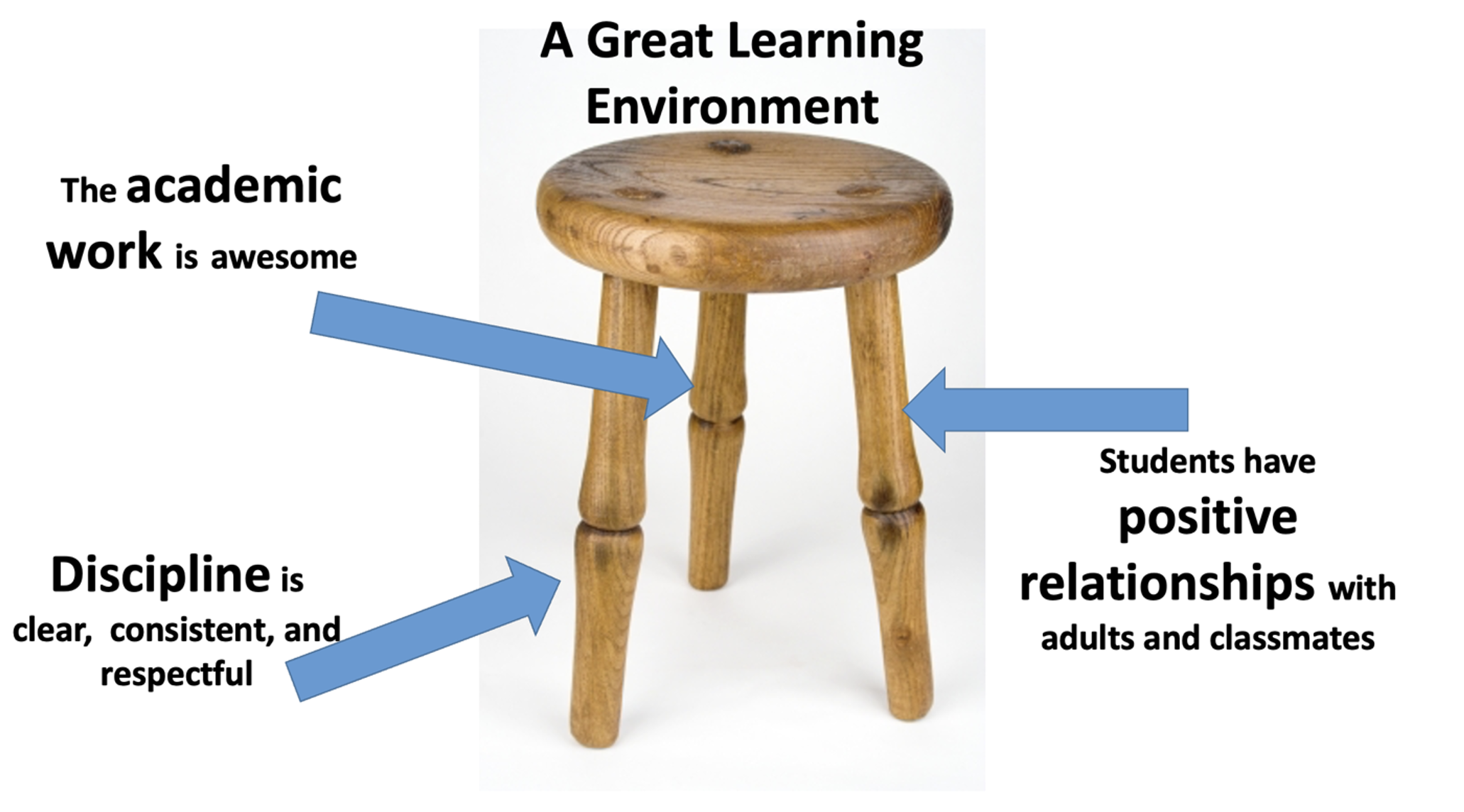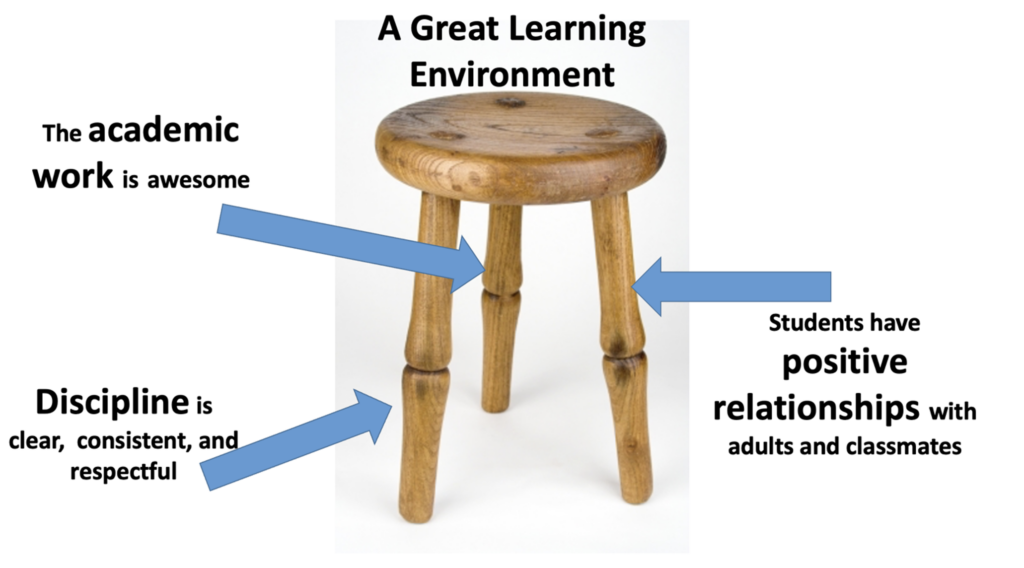How is a Great Learning Environment Like a Three-Legged Stool?

A great learning environment is like a three-legged stool. Ruth Charney first introduced this concept to me years ago. It’s an important idea to keep in mind all year long, but it’s crucial during the first weeks of school.
The environment, a place where kids can do great learning, is the seat. Each of the legs is a key component in creating that environment.
1. Academic work has to be awesome (from students’ perspectives).
2. Discipline needs to be clear, consistent, and respectful.
3. Students must develop positive relationships with adults and classmates.
What’s important about this idea is that all three need to be working in tandem to be effective. After all, if any one leg is shaky, the whole stool falls over.

Let’s explore each of the legs briefly.
Academic Work is Awesome
Students are naturally motivated to learn when their emotional needs for autonomy, purpose, belonging, competence, curiosity, and fun are met through their work. Students should have at least some choice about what (and how) they learn. Learning should be active and interactive. There should be kid-centric purpose to their work. (Many kids don’t really care that “it’s in the curriculum” or aren’t motivated “to get a grade.”) When academic work is awesome, students can regulate their emotions and build relationships more easily.
Discipline is Clear, Consistent, and Respectful
Students feel safe when expectations are clear and reasonable and when they’re given the supports they need to be successful. Norms/rules can be created with students to boost ownership and autonomy. Clear and developmentally appropriate routines that are modeled early in the year set kids up for industry and independence. We should use clear, direct, and respectful language. When students make behavior mistakes, natural and logical consequences are like guardrails on a highway—they keep minor crashes from escalating into full-blown disasters. When discipline is clear, consistent, and respectful, students feel safe enough to engage in dynamic academic work and to build and maintain positive relationships—with teachers and peers.
Students Have Positive Relationships with Adults and Classmates
People crave connection. It’s a fundamental human need just barely above our needs for food, water, shelter, and safety on Maslow’s hierarchy. Students need to know that we know them and like them. Students need to form positive connections with other students. Importantly, kids don’t all need to be friends with each other, but they do need to know that they’re valued for who they are and that they are liked by others. When they do, they are more positive about coming to school and can better engage in collaborative work. Kids can better engage with academic content when they enjoy their teachers’ company. After all, as Rita Pearson points out in her dynamic TED Talk, “Kids don’t learn from people they don’t like.”
The Three Legs in the First Weeks of School
For many years, the conventional wisdom was that early in the year, you needed to focus on two of the legs in particular (relationships and discipline) so that you could get to academics later on. When I wrote the second edition of The First Six Weeks of School, one of my major goals was to show how academics are also central to the first weeks of school. After all, if we’re trying to build communities of learners, relationships should be built within the context of learning.
The same goes with discipline. Effective norms support great learning. Many routines are academic, and these routines should be taught and practiced in the first weeks of school to support independent learning the rest of the year.
So, let’s use academic times to build relationships and connections and to set up routines and expectations that will allow students to really fly once the first weeks of school are finished!
A Few Ideas to Get You Going
When building norms with your students…
- Have students articulate goals they have—both social and academic. (“I’d like to get better at writing this year.” “I’d like to get better at working in groups.”)
- Ask them what kind of learning community they want to build. (“How should people work together this year so we can do great work?”)
- Have students generate ideas for norms that will help build a positive and productive learning environment.
- Reinforce these norms frequently in the context of academics. (“We’re about to play a math game. How can we use our norm about being respectful to help the game go well?”)
Set up academic routines you’ll use all year—routines such as…
- Partner chats (see warning below!)
- Choosing good books for independent reading
- Finding good places in the room to work effectively
- Getting out (and putting away) academic materials and supplies
- How to ask peers or teachers for advice/support with work
- Many more!
Facilitate academic lessons/activities that build student connections such as…
- Have students share favorite books/authors/genres as you’re unveiling the classroom library.
- Use activities such as Four Corners, Concentric Circles, Card Matching, and Mix and Mingle to Music to blend social and academic topics for discussions.
- Have students write non-fiction pieces about topics they know well (sports, hobbies, games, family members, etc.) and have students share those pieces with each other.
(Warning! For the love of Pete, especially early in the year, don’t let students pick their own partners! This almost always ends up with some students feeling unwanted—eroding their trust in you and shutting down their ability to engage academically.)
Those are a few ideas to consider as you get going this year. As you think about a great learning environment as a 3-legged stool, what other ideas come to mind? Feel free to share them in the comments section of this blog for others to consider!
Author
-
Mike Anderson has been an educator for many years. A public school teacher for 15 years, he has also taught preschool, coached swim teams, and taught university graduate level classes. He now works as a consultant providing professional learning for teachers throughout the US and beyond. In 2004, Mike was awarded a national Milken Educator Award, and in 2005 he was a finalist for NH Teacher of the Year. In 2020, he was awarded the Outstanding Educational Leader Award by NHASCD for his work as a consultant. A best-selling author, Mike has written ten books about great teaching and learning. His latest book is Rekindle Your Professional Fire: Powerful Habits for Becoming a More Well-Balanced Teacher. When not working, Mike can be found hanging with his family, tending his perennial gardens, and searching for new running routes around his home in Durham, NH.
- Share:
You may also like

Finding Time for a One-on-One Problem-Solving Conference
- October 23, 2024
- by Mike Anderson
- in Blog

Feeling Burned Out? Maybe It’s Time for a Shake-Up!
Leave a ReplyCancel reply
This site uses Akismet to reduce spam. Learn how your comment data is processed.



Comments
I completely agree with the idea that a great learning environment is like a three-legged stool. Each of the three components—awesome academic work, clear and respectful discipline, and positive relationships—is essential to creating a classroom that fosters learning and growth for all students. As an educator, it is important to keep all three legs in balance and constantly work on strengthening and reinforcing them throughout the school year.
I particularly appreciate the emphasis on the first few weeks of school and how critical they are in setting the tone for the rest of the year. It is crucial to establish clear expectations and routines from the beginning, as well as take the time to build positive relationships with students. This sets the foundation for a successful learning environment and makes it easier to manage any behavioral issues that may arise.
I also appreciate the suggestions for incorporating norms and routines into academic lessons and activities. This not only helps to reinforce them, but it also shows students the relevance and importance of these norms in their learning. And the idea of incorporating activities that foster student connections is key to creating a sense of community and belonging within the classroom.
Overall, I agree that all three legs of the stool play a vital role in creating a successful learning environment. By constantly working on strengthening and balancing these components, teachers can create a classroom where students are motivated, engaged, and feel safe to take risks and learn.